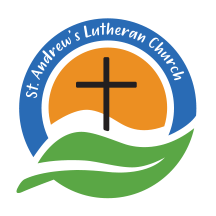During the 1950’s, the Lutheran population in Lower Providence Township was growing rapidly; however, there was no Lutheran church in the immediate area. Individuals had to drive to Norristown, Phoenixville, and Trappe to attend a Lutheran church service. As the Audubon area continued to grow, the need for a local Lutheran church became more and more apparent. In 1959, St. Andrew’s Evangelical Church was organized. The original congregation met in a rented store in the Colonial Shopping Center in Eagleville. The Rev. James Austin was called as St. Andrew’s first pastor. In one year, church membership had grown so much that it was necessary to rent the adjacent store as well. The congregation continued to grow rapidly.
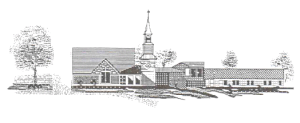 In 1960, the present ground was purchased. In 1962, the first sanctuary was built. The Rev. John G. Huber, Jr. accepted the call to St. Andrew’s in 1965. Dramatic growth continued under his leadership. Soon additional programmatic space was needed. Fellowship Hall was added and dedicated in 1971. St. Andrew’s Nursery School was established in 1972 and went on to become the pre-eminent nursery school in the area.
In 1960, the present ground was purchased. In 1962, the first sanctuary was built. The Rev. John G. Huber, Jr. accepted the call to St. Andrew’s in 1965. Dramatic growth continued under his leadership. Soon additional programmatic space was needed. Fellowship Hall was added and dedicated in 1971. St. Andrew’s Nursery School was established in 1972 and went on to become the pre-eminent nursery school in the area.
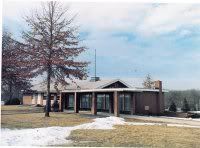 In 1985, the Rev. Thomas T. Kochenderfer, Jr. accepted the call to St. Andrew’s. Once again, a space crunch was felt in all areas of the church life. Additional space was needed for worship, Christian Education, Social Ministry programs, as well as for the Nursery School. A Long-Range Planning Committee was formed to study the congregation’s needs and to propose solutions to the space crunch problem.
In 1985, the Rev. Thomas T. Kochenderfer, Jr. accepted the call to St. Andrew’s. Once again, a space crunch was felt in all areas of the church life. Additional space was needed for worship, Christian Education, Social Ministry programs, as well as for the Nursery School. A Long-Range Planning Committee was formed to study the congregation’s needs and to propose solutions to the space crunch problem.
 In 1994, the congregation embarked on yet another building program. By December 1995, a magnificent new sanctuary and beautiful St. Andrew’s Hall were built and renovations to the original sanctuary were completed. Fellowship Hall area renovations were completed by February 1996, followed by final landscaping to the church grounds during the Spring.
In 1994, the congregation embarked on yet another building program. By December 1995, a magnificent new sanctuary and beautiful St. Andrew’s Hall were built and renovations to the original sanctuary were completed. Fellowship Hall area renovations were completed by February 1996, followed by final landscaping to the church grounds during the Spring.
As a consequence of the new sanctuary and renovated facilities, the congregation continued to grow and soon was faced with another space crunch; not enough room for classes, meetings and storage. In May of 2006, the congregation voted to buy the adjacent property on the east side of our parking lot. During the summer, the necessary renovations were made, making space in the house useable for classes, meetings, and youth activities. This has given us breathing room for our programs and opens up other options for the future.
In 2010, the Rev. William Mueller became the fourth pastor of St. Andrew’s Church. Over the past decade, Pastor Mueller along with long time members and newer folks in our faith community, have enriched our worship and education life with energetic and creative partnerships. As a congregation we have experienced the rich blessing of multiple generations working and worshiping together. Together we have re-imagined confirmation and youth ministries, expanded adult education opportunities and the creation of small groups. This has strengthened our community presence particularly with a growing senior population.
On 2021, Pastor Mueller worked with the leadership of our congregation and many generous servants to complete our latest building project, providing more flexible, safe, and accessible worship and meeting spaces for our congregation and surrounding community.
The Holy Spirit Rose Window
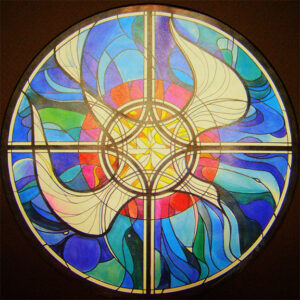
Artist original sketch
The Holy Spirit Rose Window above the baptistry depicts the third person of the Trinity present at Jesus’ baptism. “And the Holy Spirit descended upon him in bodily form like a dove@ (Luke 3:22a).” The dove is shown descending. The dove hovers in a protecting manner with wings outspread over all who are baptized at the font below, over the congregation, and indeed over all creation. The dove is white with accents of rose and mauve. These colors communicate purity, love and commitment. The red circle, as in the Creation Window, signifies the divine presence. The other colors and forms behind the dove show that the Holy Spirit, present at the beginning of everything, continues to permeate all of God’s rich creation as he calls, gathers, and enlightens the whole Church.
The Baptistry Panel and Doors (Matthew 3:13-17)

Artist original sketch
The sanctuary is separated from the narthex by a series of glass panels and two doors. Etched on the center panel, two doors and two side panels is the scene of the baptism of Jesus. John the Baptist is the tall figure pouring water on Jesus’ head. The Holy Spirit in the form of a dove is hovering above Jesus. The curving lines encompassing the scene symbolize divine power pouring forth from the Holy Spirit. The water in which Jesus is standing is the river Jordan. It flows across the two doors onto the side panels. Whenever people pass through these doors, they symbolically walk through Jordan and Jesus’ baptism to the Promised Land on the other side.
The two designs on the end panels at both ends of the narthex are the seal of Martin Luther.
The Creation Rose Window
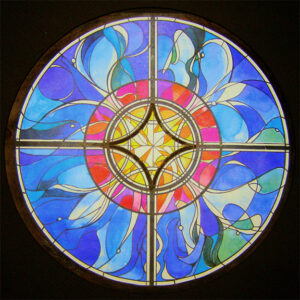
Artist original sketch
The Creation Rose Window above the reredos depicts God’s first act of creation, the creation of light. “Then God said, ‘Let there be light,’ and there was light” (Genesis 1:3). The window is a kaleidoscope of form and color; a controlled explosion of form and color. Its symmetry depicts power just beginning to bring order out of chaos. Starting with hot whites in the center, the colors cool into yellows, oranges, reds, and finally purples, greens and blues. The red circle indicates the divine presence. Also visible throughout the window are hints of things that God will be creating in the future: magnetic fields, solar winds, rivers, fish, birds, flowers, depths of sky and sea. The window in its entirety is a symbol for God the Father, Creator of everything, who, unlike his creation, is invisible.
The Pentecost Window
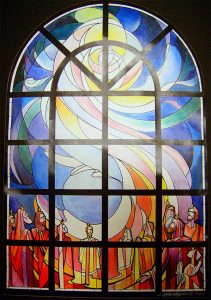
Artist original sketch
The Pentecost Window on the east side of the church depicts the arrival of the Holy Spirit. “And suddenly from heaven there came a sound like the rush of a violent wind…Divided tongues, as of fire, appeared among them, and a tongue rested on each of them. All of them were filled with the Holy Spirit and began to speak in other languages, as the Spirit gave them ability” (Acts 2:2-4).
The holy wind, depicted by warm rose and mauve waving forms that connect the upper and lower sections of the window, has an immediate effect on the disciples shown at the bottom. The tongues of fire set them ablaze with enthusiasm for the mission; empowers them with communication and organizational skills, courage and enlightenment. The increasing presence of red in the disciples= clothing indicates their being permeated by the Spirit. Their arrangement in a half circle indicates that they are getting organized to carry out the divine will to evangelize the world.
The Altar Cross
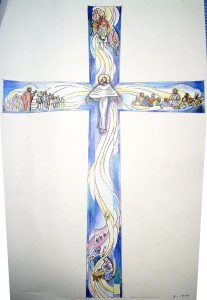
Artist Original Drawing
The Altar Cross depicts high points from the life of the second person of the Trinity, our Lord and Savior Jesus Christ. It is the focal point of the church. Each of the five scenes illustrates one of the honorific titles Jesus bears.

Artist Original Drawing
At the top of the cross, we see Christ the Judge sitting on the judgment seat with the scales of Justice at his feet. He is attended by angels heralding the resurrection to judgment. The red cloak he wears guarantees that Justice will be tempered with divine mercy (Apostles’ Creed, Second Article).
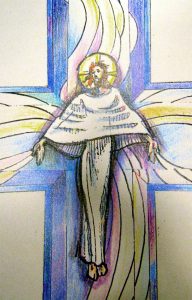
Artist Original Drawing
Directly beneath Christ the Judge at the center of the cross is Christ the Victor. Jesus radiates power and serenity, as with a simple flip of the wrist or twitch of an eye, he snaps the bonds of death; so mighty is the Son of God. The resurrection is the center of our cross and the center of our faith (I Corinthians 15:12-26).
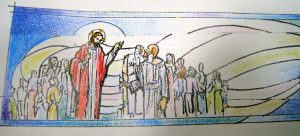
Artist Original Drawing
To the left of Christ the Victor is Christ the Teacher. The scene shows Jesus teaching the crowds in the Sermon on the Mount. One of the most beloved parts of the Sermon on the Mount are the Beatitudes (Matthew 5:1-12). Jesus taught wherever he went. Sometimes he used stories (parables). Sometimes he used healings and exorcisms. But his intention was always to communicate God’s will to his people.
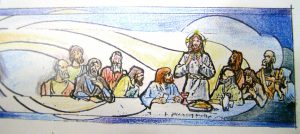
Artist Original Drawing
To the right of Christ the Victor is Christ the Bread of Life. Here we see Jesus presiding at the Last Supper. Looking to the future, he institutes the Sacrament of the Altar, Holy Communion, so that his followers will always have Him with them. He gives himself as the Bread of Life to nourish and strengthen his followers’ relationship to him. Holy food sustains a holy people and enables them to witness and serve in a fallen world (Matthew 26:26-29).
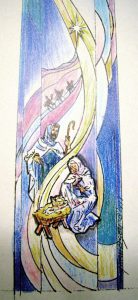
Artist Original Drawing
The scene at the bottom of the cross is Christ, the Incarnate Word. The baby Jesus is God made flesh; God born into the world a human being. As the rest of the cross shows, this baby has his work cut out for him. That work is nothing less than the salvation of the world (Luke 2:1-20).
The five scenes on the cross are connected by swirling forms, the holy wind, the Holy Spirit. When the cross is illuminated with proper lighting, the shadows of two other crosses appear. The thieves crucified on either side of Jesus signify all of humanity; those who believe in and those who reject Jesus as the Son of God, the Second Person of the Trinity.
The Ascension Window
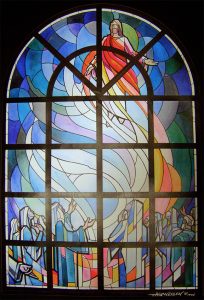
Artist original sketch
The Ascension Window on the west side of the church depicts Jesus returning to heaven, his work on earth completed. The disciples depicted at the bottom of the window have just heard his final words. “But you will receive power when the Holy Spirit has come upon you; and you will be my witnesses in Jerusalem, in all Judea and Samaria, and to the ends of the earth” (Acts 1:8). Jesus is clothed in red, indicating the presence of divinity. Red also reminds us of his promise to send the Holy Spirit. The disciples are clothed in cool colors, and arranged haphazardly. They have not yet been organized and empowered to carry out the great challenge of witnessing to the world. But hints of that empowerment are visible. The holy wind is beginning to move. The cool waving forms in the center of the window that connect Jesus and the disciples indicate that something is going to happen. God is about to stir things up. The promised Holy Spirit is not far off and is eager to be unleashed on the world.
